A Finite Element Model for Predicting the Static Strength of a Composite Hybrid Joint with Reinforcement Pins
Abstract
:1. Introduction
2. Materials and Test Specimens
3. Model Descriptions
3.1. Single-Pin Model
3.2. Structural Model of Pin-Reinforced Joints
4. Modelling Results
4.1. Force vs. Applied Displacement
4.2. Interlaminar Shear Stresses
4.3. Parametric Studies by FEA and Discussions
4.3.1. Thickness of Metal Adherend
4.3.2. Pin Row Number
4.3.3. Parameters of Single-Pin Traction–Separation Laws
4.4. Summary of Important Points Based on the Modelling Work
5. Experimental Observations on the Effect of Pin Array Arrangement
6. Conclusions
- The bridging force exerted by micro pins can be modelled by the nonlinear spring elements and the cohesive interface elements. Bridging laws governing these pin models can be obtained either by testing single-pin specimens or using the unit-cell models.
- Both pin models can be implemented in a commercial finite element software package for modelling structural failure behaviour of lap joints.
- The spring-pin model can better simulate the joint response to the complete failure of the joint, whereas the cohesive-pin model has less good agreement with the experimental curve, owing to the over-simplified traction–separation law for the single-pin model.
- Increase in the pin numbers along the path of the debonding crack will increase the structural performance of the joint. The hybrid joint should be designed with a higher number of pins at the joint runout, where the shear stress is the highest, hence being the most critical for debonding damage.
- A synergistic effect of the metal substrate stiffness and pin array variation on the joint strength and damage tolerance properties has been demonstrated by testing two different metal adherend thicknesses. This should be further investigated by modelling and parametric studies to optimise the design of hybrid joints.
Author Contributions
Funding
Institutional Review Board Statement
Informed Consent Statement
Data Availability Statement
Acknowledgments
Conflicts of Interest
References
- Adams, R.D.; Harris, J.A. The Influence of Local Geometry on the Strength of Adhesive Joints. Int. J. Adhes. Adhes. 1987, 7, 69–80. [Google Scholar] [CrossRef]
- Matthews, F.L.; Kilty, P.F.; Godwin, E.W. A Review of the Strength of Joints in Fibre-Reinforced Plastics. Part 2. Adhesively Bonded Joints. Composites 1982, 13, 29–37. [Google Scholar] [CrossRef]
- Hart-Smith, L.J. Adhesive-Bonded Double-Lap Joints; NASA-CR-112235; NASA: Washington, DC, USA, 1973.
- Jeevi, G.; Nayak, S.K.; Abdul Kader, M. Review on Adhesive Joints and Their Application in Hybrid Composite Structures. J. Adhes. Sci. Technol. 2019, 33, 1497–1520. [Google Scholar] [CrossRef]
- Mouritz, A.P. Review of Z-Pinned Composite Laminates. Compos. Part A Appl. Sci. Manuf. 2007, 38, 2383–2397. [Google Scholar] [CrossRef]
- Parkes, P.N.; Butler, R.; Meyer, J.; de Oliveira, A. Static Strength of Metal-Composite Joints with Penetrative Reinforcement. Compos. Struct. 2014, 118, 250–256. [Google Scholar] [CrossRef]
- Hart-Smith, L.J. Bonded-Bolted Composite Joints. J. Aircr. 1985, 22, 993–1000. [Google Scholar] [CrossRef]
- Kelly, G. Quasi-Static Strength and Fatigue Life of Hybrid (Bonded/Bolted) Composite Single-Lap Joints. Compos. Struct. 2006, 72, 119–129. [Google Scholar] [CrossRef]
- Kradinov, V.; Madenci, E.; Ambur, D.R. Bolted Lap Joints of Laminates with Varying Thickness and Metallic Inserts. Compos. Struct. 2005, 68, 75–85. [Google Scholar] [CrossRef]
- Kolesnikov, B.; Herbeck, L.; Fink, A. CFRP/Titanium Hybrid Material for Improving Composite Bolted Joints. Compos. Struct. 2008, 83, 368–380. [Google Scholar] [CrossRef]
- Camanho, P.P.; Fink, A.; Obst, A.; Pimenta, S. Hybrid Titanium–CFRP Laminates for High-Performance Bolted Joints. Compos. Part A Appl. Sci. Manuf. 2009, 40, 1826–1837. [Google Scholar] [CrossRef]
- Fink, A.; Camanho, P.P.; Andrés, J.M.; Pfeiffer, E.; Obst, A. Hybrid CFRP/Titanium Bolted Joints: Performance Assessment and Application to a Spacecraft Payload Adaptor. Compos. Sci. Technol. 2010, 70, 305–317. [Google Scholar] [CrossRef]
- Tu, W.; Wen, P.H.; Hogg, P.J.; Guild, F.J. Optimisation of the Protrusion Geometry in ComeldTM Joints. Compos. Sci. Technol. 2011, 71, 868–876. [Google Scholar] [CrossRef]
- Tu, W.; Wen, P.H.; Guild, F.J. Multi-Region Mesh Free Method for ComeldTM Joints. Comput. Mater. Sci. 2010, 48, 481–489. [Google Scholar] [CrossRef]
- Ucsnik, S.; Scheerer, M.; Zaremba, S.; Pahr, D.H. Experimental Investigation of a Novel Hybrid Metal–Composite Joining Technology. Compos. Part A Appl. Sci. Manuf. 2010, 41, 369–374. [Google Scholar] [CrossRef]
- Sarantinos, N.; Kostopoulos, V.; Di Vita, G.; Campoli, G.; Bricout, L. Micro-Pins: The next Step in Composite–Composite and Metal–Composite Joining. CEAS Space J. 2019, 11, 351–358. [Google Scholar] [CrossRef]
- Popp, J.; Kleffel, T.; Römisch, D.; Papke, T.; Merklein, M.; Drummer, D. Fiber Orientation Mechanism of Continuous Fiber Reinforced Thermoplastics Hybrid Parts Joined with Metallic Pins. Appl. Compos. Mater. 2021, 28, 951–972. [Google Scholar] [CrossRef]
- Joesbury, A.M. New Approaches to Composite Metal Joining. Ph.D. Thesis, Cranfield University, Bedford, UK, 2015. [Google Scholar]
- Seidlitz, H.; Fritzsche, S.; Ambrosio, M.; Kloshek, A.; Seidlitz, H.; Fritzsche, S.; Ambrosio, M.; Kloshek, A. Advanced Welding Technology for Highly Stressable Multi-Material Designs with Fiber-Reinforced Plastics and Metals. Open J. Compos. Mater. 2017, 7, 166–177. [Google Scholar] [CrossRef]
- Graham, D.P.; Rezai, A.; Baker, D.; Smith, P.A.; Watts, J.F. The Development and Scalability of a High Strength, Damage Tolerant, Hybrid Joining Scheme for Composite–Metal Structures. Compos. Part A Appl. Sci. Manuf. 2014, 64, 11–24. [Google Scholar] [CrossRef]
- Heimbs, S.; Nogueira, A.C.; Hombergsmeier, E.; May, M.; Wolfrum, J. Failure Behaviour of Composite T-Joints with Novel Metallic Arrow-Pin Reinforcement. Compos. Struct. 2014, 110, 16–28. [Google Scholar] [CrossRef]
- Lang, H.; Nogueira, A.C.; Jürgens, M.; Hombergsmeier, E.; Hinterhölzl, R.; Drechsler, K. Investigation on the Structural Behavior of a Metallically 3D-Reinforced CFRP/CFRP Joint Using a Variable Search Based on Finite Element Analyzes. Compos. Struct. 2016, 139, 199–209. [Google Scholar] [CrossRef]
- Sarantinos, N.; Tsantzalis, S.; Ucsnik, S.; Kostopoulos, V. Review of Through-the-Thickness Reinforced Composites in Joints. Compos. Struct. 2019, 229, 111404. [Google Scholar] [CrossRef]
- Partridge, I.K.; Cartié, D.D.R.; Bonnington, T. Manufacture and Performance of Z-Pinned Composites. In Advanced Polymeric Materials: Structure Property Relationships; Advani, S., Shonaike, G., Eds.; CRC Press: Boca Raton, FL, USA, 2003; Chapter 3; pp. 103–138. ISBN 9780203492901. [Google Scholar]
- Partridge, I.; Cartié, D.; Troulis, M.; Grassi, M.; Zhang, X. Evaluating the Mechanical Effectiveness of Z-Pinning. In Proceedings of the SAMPE Technical Conference, San Diego, CA, USA, 15–18 November 2004. [Google Scholar]
- Sugiman, S.; Ahmad, H. Comparison of Cohesive Zone and Continuum Damage Approach in Predicting the Static Failure of Adhesively Bonded Single Lap Joints. J. Adhes. Sci. Technol. 2016, 31, 552–570. [Google Scholar] [CrossRef]
- Ferreira, C.L.; Campilho, R.D.S.G.; Moreira, R.D.F. Experimental and Numerical Analysis of Dual-Adhesive Stepped-Lap Aluminum Joints. Proc. Inst. Mech. Eng. Part E 2020, 234, 454–464. [Google Scholar] [CrossRef]
- Rocha, R.J.B.; Campilho, R.D.S.G. Evaluation of Different Modelling Conditions in the Cohesive Zone Analysis of Single-Lap Bonded Joints. J. Adhes. 2017, 94, 562–582. [Google Scholar] [CrossRef]
- Park, K.; Paulino, G.H.; Roesler, J.R. A Unified Potential-Based Cohesive Model of Mixed-Mode Fracture. J. Mech. Phys. Solids 2009, 57, 891–908. [Google Scholar] [CrossRef]
- Ghabezi, P.; Farahani, M. A Cohesive Model with a Multi-Stage Softening Behavior to Predict Fracture in Nano Composite Joints. Eng. Fract. Mech. 2019, 219, 106611. [Google Scholar] [CrossRef]
- Katsivalis, I.; Thomsen, O.T.; Feih, S.; Achintha, M. Development of Cohesive Zone Models for the Prediction of Damage and Failure of Glass/Steel Adhesive Joints. Int. J. Adhes. Adhes. 2020, 97, 102479. [Google Scholar] [CrossRef]
- Funari, M.F.; Greco, F.; Lonetti, P.; Luciano, R.; Penna, R. An Interface Approach Based on Moving Mesh and Cohesive Modeling in Z-Pinned Composite Laminates. Compos. Part B Eng. 2018, 135, 207–217. [Google Scholar] [CrossRef]
- Nguyen, A.T.T.; Pichitdej, N.; Brandt, M.; Feih, S.; Orifici, A.C. Failure Modelling and Characterisation for Pin-Reinforced Metal-Composite Joints. Compos. Struct. 2018, 188, 185–196. [Google Scholar] [CrossRef]
- Inverarity, S.B.; Das, R.; Mouritz, A.P. Composite-to-Metal Joining Using Interference Fit Micropins. Compos. Part A Appl. Sci. Manuf. 2022, 156, 106895. [Google Scholar] [CrossRef]
- Liu, L. A Study of the Damage Tolerance of Composite-Metal Hybrid Joints Reinforced by Multiple and Penetrative Thin Pins. Compos. Adv. Mater. 2022, 31, 263498332211055. [Google Scholar] [CrossRef]
- Bianchi, F.; Zhang, X. A Numerical Model for Hybrid Metal-Composite Joints with through-Thickness Reinforcement. In Proceedings of the 53rd AIAA/ASME/ASCE/AHS/ASC Structures, Structural Dynamics and Materials Conference 20th AIAA/ASME/AHS Adaptive Structures Conference 14th AIAA, Honolulu, HI, USA, 23–26 April 2012. [Google Scholar] [CrossRef]
- Kwiecień, S.; Pilarczyk, W.; Harapińska, E. Analysis of the Structure and Selected Properties of Welds Obtained by the CMT and MAG Method. Weld. Technol. Rev. 2020, 92, 45–51. [Google Scholar] [CrossRef]
- Butler, J.; (Cranfield University, Bedford, UK). Technical Report, Unpublished. 2011.
- Bianchi, F. Numerical Modelling of Through-Thickness Reinforced Structural Joints. Ph.D. Thesis, Cranfield University, Bedford, UK, 2012. [Google Scholar]
- Rasmussen, K.J.R. Full-Range Stress–Strain Curves for Stainless Steel Alloys. J. Constr. Steel Res. 2003, 59, 47–61. [Google Scholar] [CrossRef]
- Bianchi, F.; Zhang, X. A Cohesive Zone Model for Predicting Delamination Suppression in Z-Pinned Laminates. Compos. Sci. Technol. 2011, 71, 1898–1907. [Google Scholar] [CrossRef]
- Bianchi, F.; Koh, T.M.; Zhang, X.; Partridge, I.K.; Mouritz, A.P. Finite Element Modelling of Z-Pinned Composite T-Joints. Compos. Sci. Technol. 2012, 73, 48–56. [Google Scholar] [CrossRef]
- Grassi, M.; Cox, B.; Zhang, X. Simulation of Pin-Reinforced Single-Lap Composite Joints. Compos. Sci. Technol. 2006, 66, 1623–1638. [Google Scholar] [CrossRef]



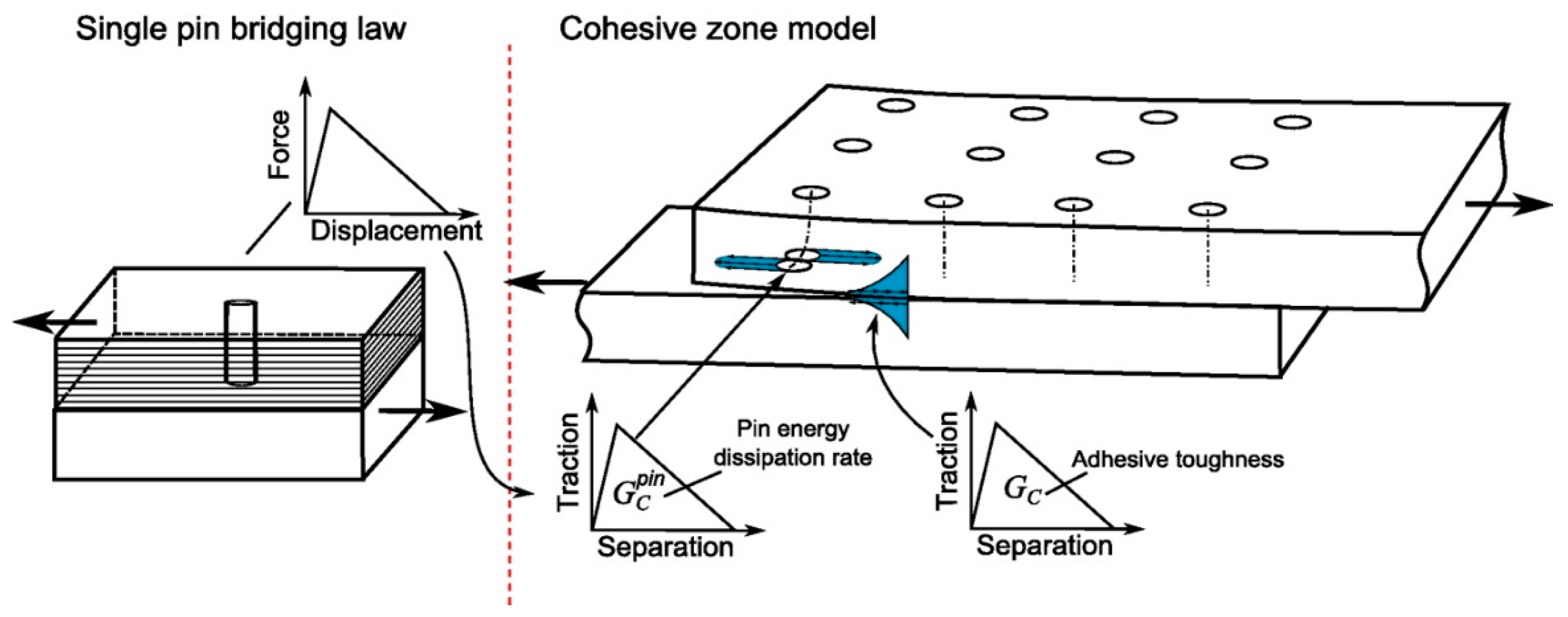
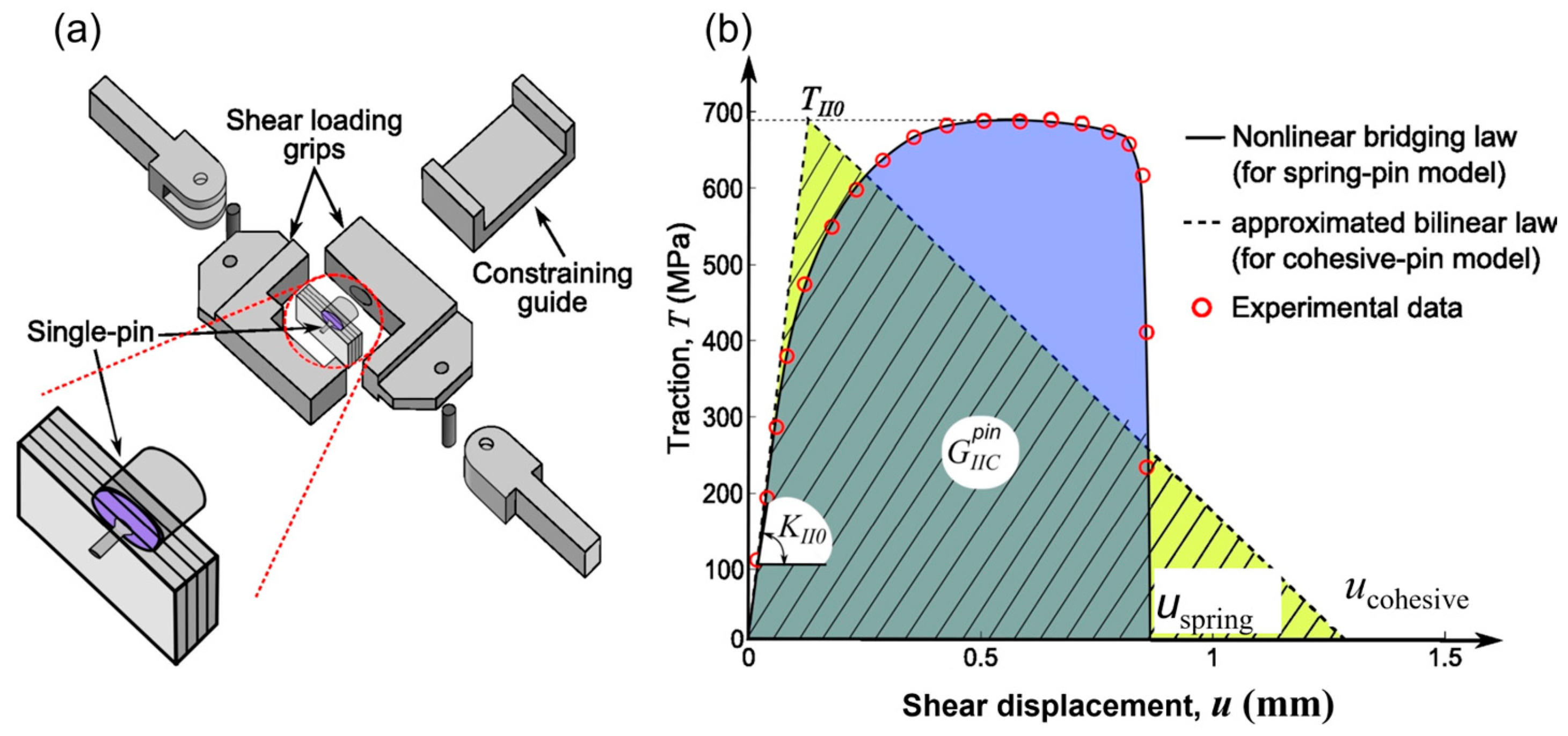
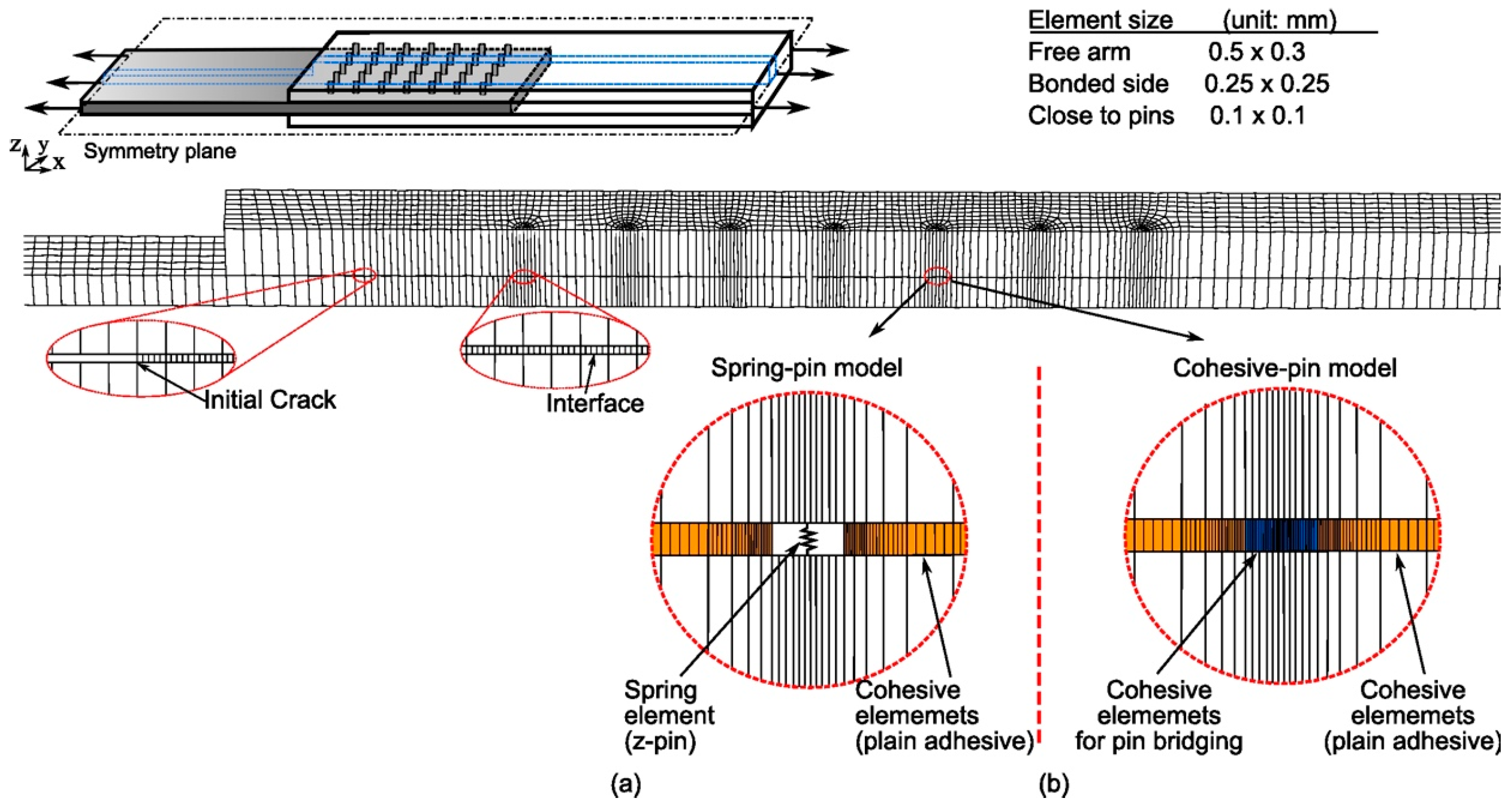


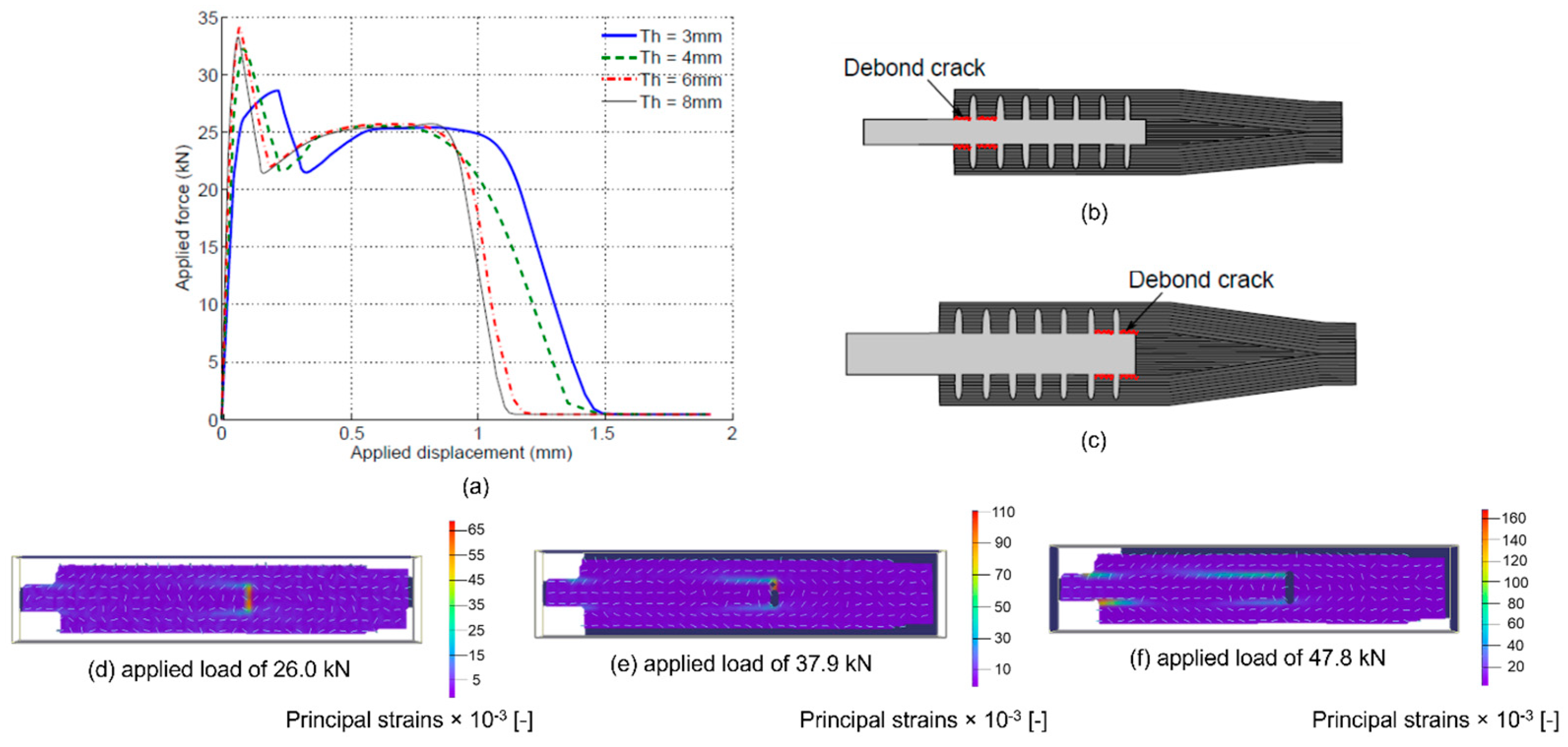
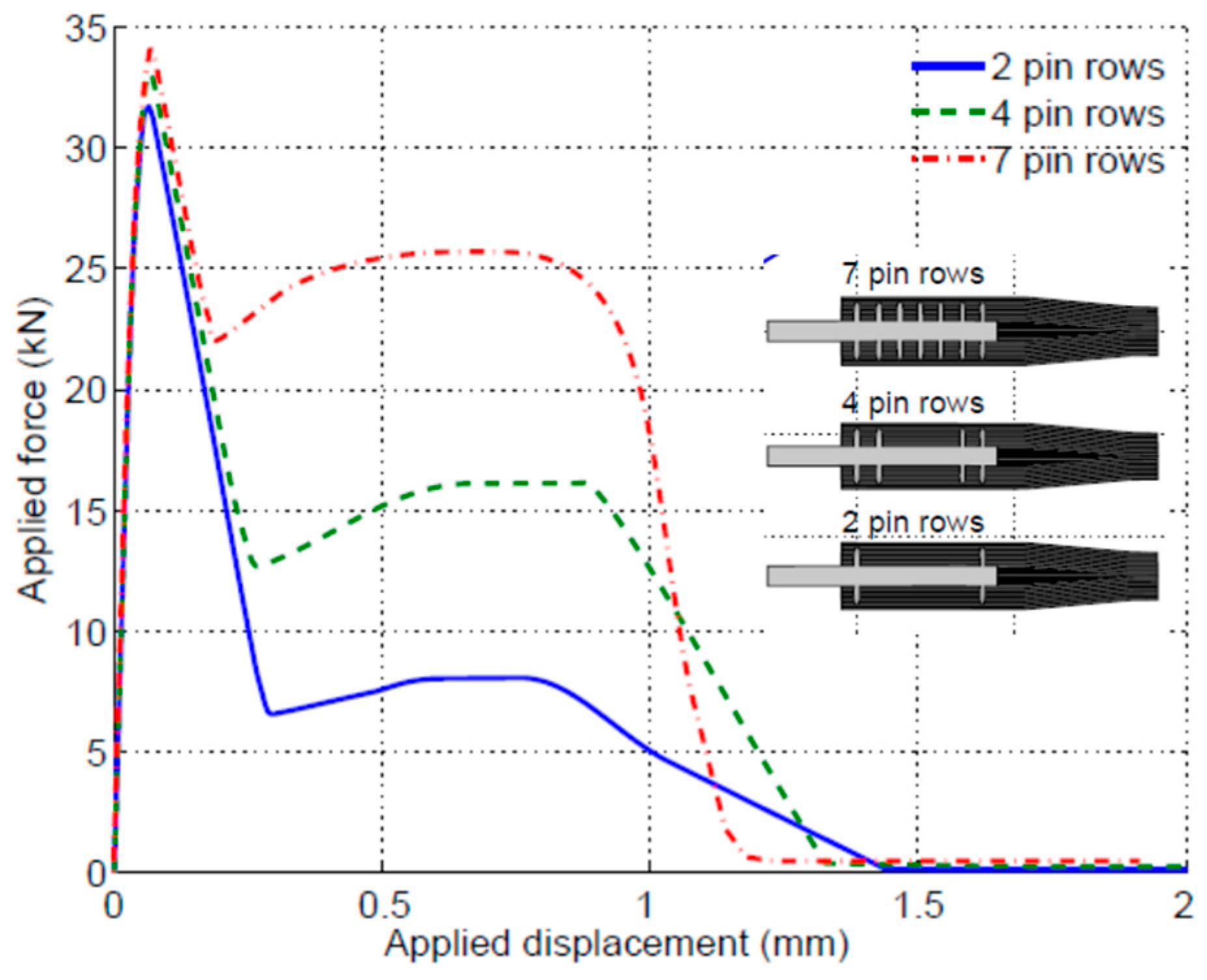


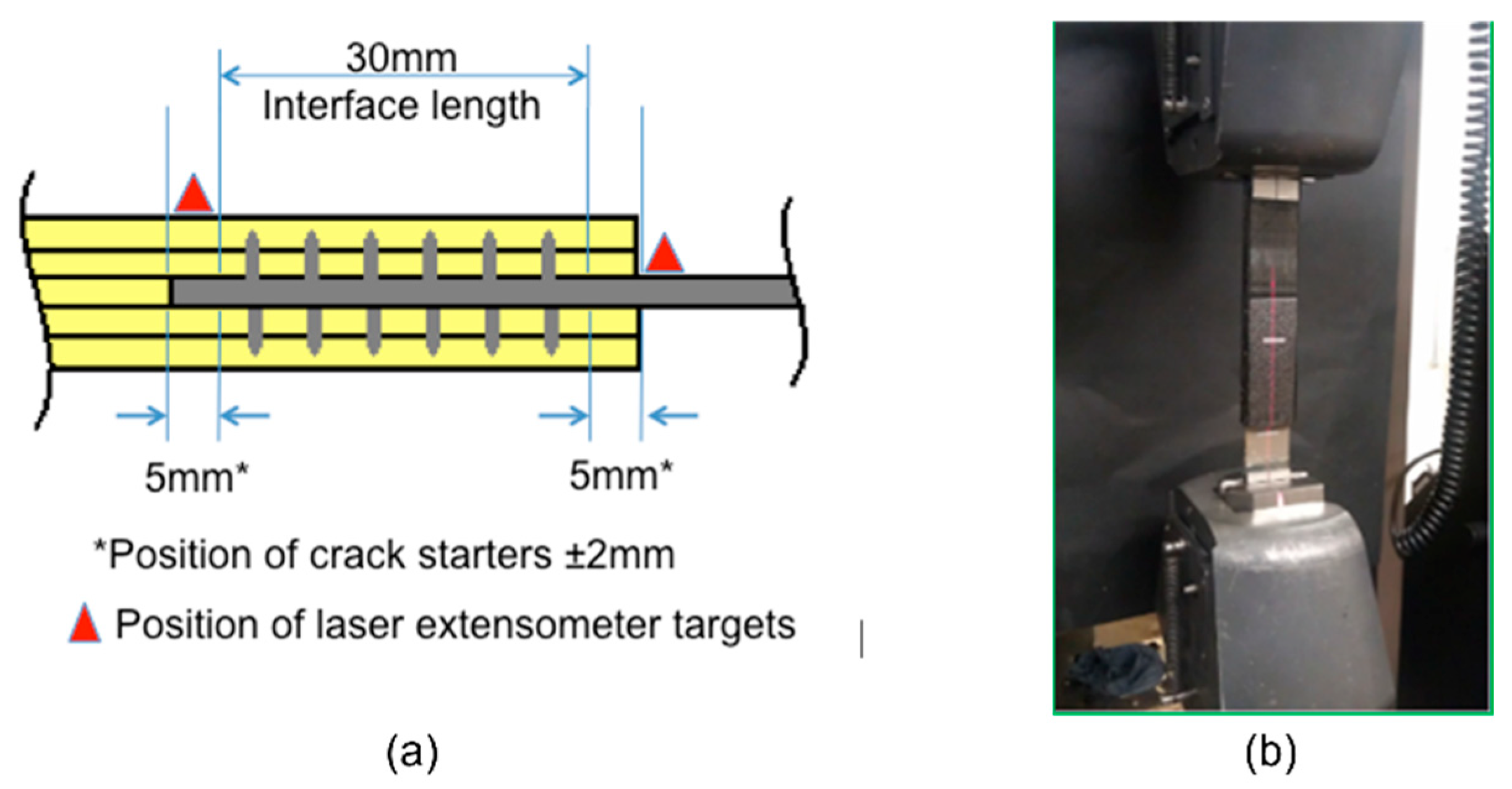

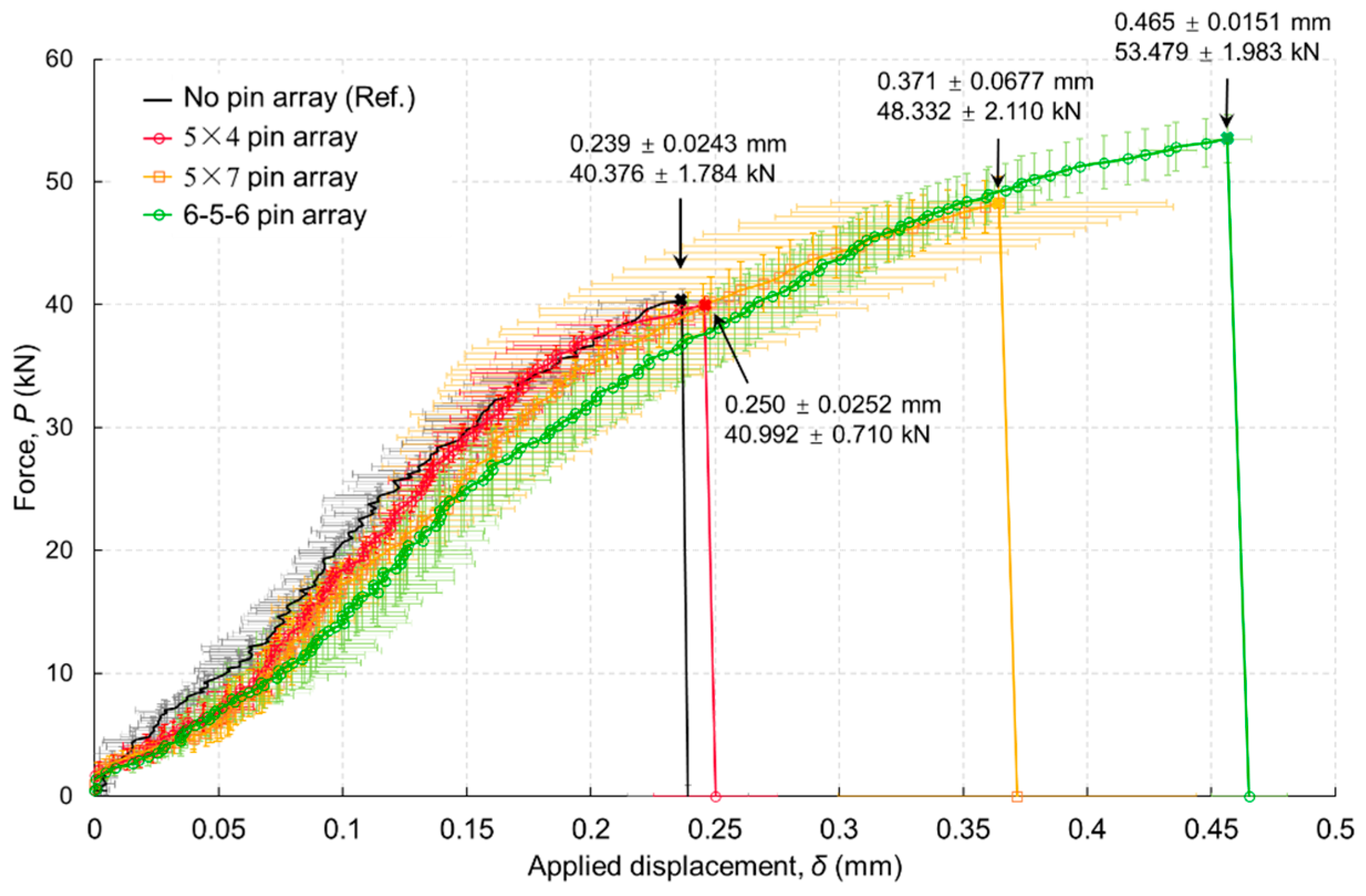
| Property | Value |
|---|---|
| Composite adherend (unidirectional carbon fibre/epoxy Hexcel T700/M21) | |
| Young’s modulus in longitudinal direction (E11) | 120 GPa |
| Young’s moduli in transverse directions (E22, E33) | 11 GPa |
| Shear moduli (G12, G13, G23) | 4.6 GPa |
| Poisson’s ratio (υ12, υ13, υ23) | 0.35 |
| Metal adherend (Stainless steel AISI-304) | |
| Young’s modulus (E) | 190 GPa |
| Poisson’s ratio (υ) | 0.33 |
| Yield strength (σY) | 290 MPa |
| Ramberg–Osgood parameter used in Equation (1) (n) | 3.8 |
| Adhesive: cohesive element properties (same material as the prepreg resin M21) | |
| Mode-I traction stiffness (KI) | 2.5 × 1013 N/m3 |
| Mode-II traction stiffness (KII) | 2.5 × 1013 N/m3 |
| Mode-I cohesive strength (TI0) | 30 MPa |
| Mode-II cohesive strength (TII0) | 70 MPa |
| Mode-I fracture toughness (GIC) | 200 J/m2 |
| Mode-II fracture toughness (GIIC) | 550 J/m2 |
Disclaimer/Publisher’s Note: The statements, opinions and data contained in all publications are solely those of the individual author(s) and contributor(s) and not of MDPI and/or the editor(s). MDPI and/or the editor(s) disclaim responsibility for any injury to people or property resulting from any ideas, methods, instructions or products referred to in the content. |
© 2023 by the authors. Licensee MDPI, Basel, Switzerland. This article is an open access article distributed under the terms and conditions of the Creative Commons Attribution (CC BY) license (https://creativecommons.org/licenses/by/4.0/).
Share and Cite
Bianchi, F.; Liu, Y.; Joesbury, A.M.; Ayre, D.; Zhang, X. A Finite Element Model for Predicting the Static Strength of a Composite Hybrid Joint with Reinforcement Pins. Materials 2023, 16, 3297. https://doi.org/10.3390/ma16093297
Bianchi F, Liu Y, Joesbury AM, Ayre D, Zhang X. A Finite Element Model for Predicting the Static Strength of a Composite Hybrid Joint with Reinforcement Pins. Materials. 2023; 16(9):3297. https://doi.org/10.3390/ma16093297
Chicago/Turabian StyleBianchi, Francesco, Yiding Liu, Adam M. Joesbury, David Ayre, and Xiang Zhang. 2023. "A Finite Element Model for Predicting the Static Strength of a Composite Hybrid Joint with Reinforcement Pins" Materials 16, no. 9: 3297. https://doi.org/10.3390/ma16093297






